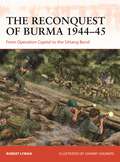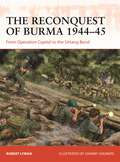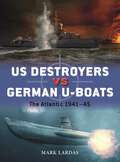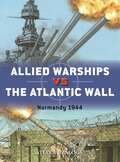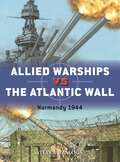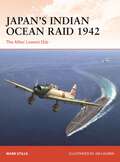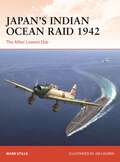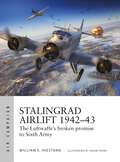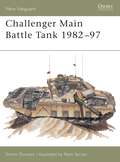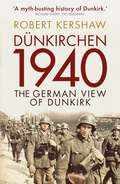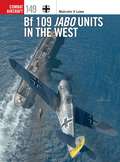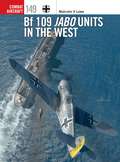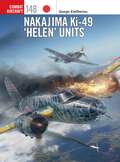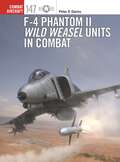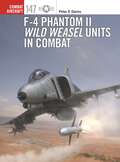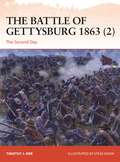- Table View
- List View
The Reconquest of Burma 1944–45: From Operation Capital to the Sittang Bend (Campaign #390)
by Robert LymanA fascinating exploration of the dramatic battles and Allied operations to wrest back control of Burma (Myanmar) from the Japanese.The Allied reconquest of Burma was not part of Allied Grand Strategy in 1944 and 1945. It happened despite it – in particular, because of the dramatic failure of the Japanese invasion of India (Operation U-Go), which ended ignominiously for the Japanese Empire in August 1944. The reconquest was one of the longest campaigns of World War II. It comprised 11 distinct battles and offensives that were part of the overall continuum of operations that resulted in the Allied victory.Written by a foremost expert on the British Army in World War II, this superbly illustrated work details the Allied operations to retake Burma from Japanese control. Accounts of Operation Capital, the capture of Meiktila and Mandalay, the Allied advance in the Arakan, the race for Rangoon, Operation Dracula, the Battle of the Sittang Bend and Japanese breakout operations across the Pegu Yomas are supported by easy to follow 2D maps and 3D diagrams. Among the events brought to life in vivid battlescene artworks are an SOE-led ambush in Operation Character, and the famous Defence of Hill 170 in the Arakan.
The Reconquest of Burma 1944–45: From Operation Capital to the Sittang Bend (Campaign #390)
by Robert LymanA fascinating exploration of the dramatic battles and Allied operations to wrest back control of Burma (Myanmar) from the Japanese.The Allied reconquest of Burma was not part of Allied Grand Strategy in 1944 and 1945. It happened despite it – in particular, because of the dramatic failure of the Japanese invasion of India (Operation U-Go), which ended ignominiously for the Japanese Empire in August 1944. The reconquest was one of the longest campaigns of World War II. It comprised 11 distinct battles and offensives that were part of the overall continuum of operations that resulted in the Allied victory.Written by a foremost expert on the British Army in World War II, this superbly illustrated work details the Allied operations to retake Burma from Japanese control. Accounts of Operation Capital, the capture of Meiktila and Mandalay, the Allied advance in the Arakan, the race for Rangoon, Operation Dracula, the Battle of the Sittang Bend and Japanese breakout operations across the Pegu Yomas are supported by easy to follow 2D maps and 3D diagrams. Among the events brought to life in vivid battlescene artworks are an SOE-led ambush in Operation Character, and the famous Defence of Hill 170 in the Arakan.
US Destroyers vs German U-Boats: The Atlantic 1941–45 (Duel)
by Mark LardasAn absorbing study of the duels fought between the US Navy's escort warships and Hitler's U-boats between December 1941 and May 1945. Although the Battle of the Atlantic lasted several years, its most critical phase began once the United States entered World War II. By December 1941, the British had mastered the U-boat threat in the Eastern Atlantic, only to see the front abruptly expand to regions the US Navy would patrol, chiefly the Atlantic Seaboard. Unless the US Navy overcame the U-boat threat, the Allies would struggle to win. The Battle of the Atlantic was made up of thousands of individual duels: aircraft against U-boats, aircraft against aircraft, aircraft against ships-but most crucially, ships against U-boats. The individual clashes between Germany's U-boats and the Allied warships escorting the vital convoys often comprised one-on-one actions. These stories provide the focus of this detailed work. The technical details of the U-boats, destroyers, and destroyer escorts involved are explored in stunning illustrations, including ship and submarine profiles and weaponry artworks, and key clashes are brought to life in dramatic battlescenes. Among the clashes covered are including USS Kearny vs. U-568, USS Roper (DD-147) vs U-85, USS Eugene E. Elmore (DE-686) vs U-549, and USS Atherton (DE-169) vs U-853.
US Destroyers vs German U-Boats: The Atlantic 1941–45 (Duel #127)
by Mark LardasAn absorbing study of the duels fought between the US Navy's escort warships and Hitler's U-boats between December 1941 and May 1945. Although the Battle of the Atlantic lasted several years, its most critical phase began once the United States entered World War II. By December 1941, the British had mastered the U-boat threat in the Eastern Atlantic, only to see the front abruptly expand to regions the US Navy would patrol, chiefly the Atlantic Seaboard. Unless the US Navy overcame the U-boat threat, the Allies would struggle to win. The Battle of the Atlantic was made up of thousands of individual duels: aircraft against U-boats, aircraft against aircraft, aircraft against ships-but most crucially, ships against U-boats. The individual clashes between Germany's U-boats and the Allied warships escorting the vital convoys often comprised one-on-one actions. These stories provide the focus of this detailed work. The technical details of the U-boats, destroyers, and destroyer escorts involved are explored in stunning illustrations, including ship and submarine profiles and weaponry artworks, and key clashes are brought to life in dramatic battlescenes. Among the clashes covered are including USS Kearny vs. U-568, USS Roper (DD-147) vs U-85, USS Eugene E. Elmore (DE-686) vs U-549, and USS Atherton (DE-169) vs U-853.
Allied Warships vs the Atlantic Wall: Normandy 1944 (Duel #128)
by Steven J. ZalogaA fascinating exploration of the often-overlooked gunnery duels between the formidable artillery weapons in the Atlantic Wall defences and the mighty US and Royal Navy battleships.Amphibious landings were an essential tool of Allied military strategy in World War II. The Royal Navy and the US Navy provided operational mobility that allowed the Allies to strike unexpectedly across the vast coastlines of the Mediterranean and Atlantic. Nazi Germany did not have sufficient naval power to seriously contest this, and consequently relied heavily on the huge and costly Atlantic Wall fortification programme. By 1944, the French coast featured more than 1,900 coastal guns over 75mm in calibre. At the heart of this fascinating book by renowned military historian Steven J. Zaloga is the clash between Batterie Hamburg (defending Cherbourg) and the Allied naval bombardment group led by the battleship USS Texas on 25 June 1944. Stunning artworks reveal details of the design, construction and ammunition of the weapons involved, and the locations of important sites are shown on maps. The author also explores the evolution of Allied naval doctrine, which was based on repeated experiences during a succession of amphibious operations, and which enabled the Allies to successfully overcome the coastal gun threat. Illustrated with over 50 period photographs, the result is a fascinating exploration of a key battle during the Allied invasion of mainland Europe.
Allied Warships vs The Atlantic Wall: Normandy 1944 (Duel Ser. #128)
by Steven J. ZalogaA fascinating exploration of the often-overlooked gunnery duels between the formidable artillery weapons in the Atlantic Wall defences and the mighty US and Royal Navy battleships. Amphibious landings played a prominent role in Allied operations in the Mediterranean and European theatres in World War II. One of the most effective means to deter and defeat them was through the use of coastal artillery (as witnessed in the disastrous raid on Dieppe in 1942). The growing threat of an Allied invasion of France led the Germans to construct the most elaborate fortifications of the 20th century, the Atlantic Wall, which incorporated coastal artillery as the basis of its strongpoints. Given the high level of uncertainty over where the Allies would land in 1944, the Germans were obliged to deploy large numbers of coastal artillery batteries along the coast of France and the Low Countries, with the heaviest concentrations in the Pas-de-Calais. This fascinating and novel work describes the duel that played out during Operation Neptune/Overlord as the Allies responded to the threat posed by the Atlantic Wall and its modern, steel-reinforced casemates. Among the duels covered are those involving the batteries of HKAA.1261 north of Utah Beach, the naval battery at Longues-sur-Mer between Omaha and Gold beaches, the sinking of USS Corry, and the subsequent Royal Navy and US Navy bombardment of Cherbourg. The sites and locations of key events are clearly shown in helpful 2D maps, and the actions in which these weapons were involved are brought to life in stunning artworks and period photographs.
Japan’s Indian Ocean Raid 1942: The Allies' Lowest Ebb (Campaign #396)
by Mark StilleAn detailed illustrated exploration of the Japanese raid into the Indian Ocean in April 1942 – one of the largest operations conducted by the Imperial Navy during the war.In the wake of Japan's conquest of Burma in early 1942, plans were formed by the Imperial high command to capture Ceylon (modern Sri Lanka) to consolidate Japan's defensive perimeter and disrupt British shipping lanes to India, Australia, and the Middle East. The Imperial Japanese Army, however, could not release sufficient troops for an invasion, and so in response the Japanese Navy developed Operation C, an aggressive raid by the Combined Fleet into the Indian Ocean. The key objective was to destroy the British Eastern Fleet in port.Expert naval historian Mark Stille documents the high point of Japanese naval air power as its carriers struck Ceylon – the heart of British naval power in the East – sinking several Allied ships. He describes the Allied air attempts to destroy Admiral Chuichi Nagumo's force, and the Japanese attacks against British shipping and the cities along the Indian coast.Specially commissioned battlescenes bring to life the sinking of British carrier Hermes, the Bristol Blenheim attacks on the Japanese carrier force, and a Zero vs Hurricane dogfight over Colombo on 5 April. Easy to follow maps and diagrams reveal the strategic situation at the start and end of the campaign, and track the movements of the Japanese carrier task force and the British Eastern Fleet throughout. Details of weaponry, equipment, personnel and the events of the fascinating battles that took place are revealed in over 60 photographs, many of which are from Japanese sources.
Japan’s Indian Ocean Raid 1942: The Allies' Lowest Ebb (Campaign #396)
by Mark StilleAn detailed illustrated exploration of the Japanese raid into the Indian Ocean in April 1942 – one of the largest operations conducted by the Imperial Navy during the war.In the wake of Japan's conquest of Burma in early 1942, plans were formed by the Imperial high command to capture Ceylon (modern Sri Lanka) to consolidate Japan's defensive perimeter and disrupt British shipping lanes to India, Australia, and the Middle East. The Imperial Japanese Army, however, could not release sufficient troops for an invasion, and so in response the Japanese Navy developed Operation C, an aggressive raid by the Combined Fleet into the Indian Ocean. The key objective was to destroy the British Eastern Fleet in port.Expert naval historian Mark Stille documents the high point of Japanese naval air power as its carriers struck Ceylon – the heart of British naval power in the East – sinking several Allied ships. He describes the Allied air attempts to destroy Admiral Chuichi Nagumo's force, and the Japanese attacks against British shipping and the cities along the Indian coast.Specially commissioned battlescenes bring to life the sinking of British carrier Hermes, the Bristol Blenheim attacks on the Japanese carrier force, and a Zero vs Hurricane dogfight over Colombo on 5 April. Easy to follow maps and diagrams reveal the strategic situation at the start and end of the campaign, and track the movements of the Japanese carrier task force and the British Eastern Fleet throughout. Details of weaponry, equipment, personnel and the events of the fascinating battles that took place are revealed in over 60 photographs, many of which are from Japanese sources.
Stalingrad Airlift 1942–43: The Luftwaffe's broken promise to Sixth Army (Air Campaign)
by William E. HiestandThe story of what really led to Germany losing the battle of Stalingrad - the inability of the Luftwaffe to keep Sixth Army supplied throughout the winter of 1942–43 - and why this crucial airlift failed.Luftwaffe chief Hermann Goering's failure to deliver his promise to keep Sixth Army supplied at Stalingrad was one of the most hard-hitting strategic air failures of World War II. 300 tons a day of supplies were required to sustain the Sixth Army, flown in against a Soviet fighter force whose capabilities were rapidly being transformed. The Luftwaffe's failure left Sixth Army trapped, vulnerable and too weak to attempt a breakout. The destruction of Sixth Army was one of the major turning points in World War II but the Luftwaffe's crucial role in this disaster has often been overlooked. Some claim the attempt was doomed from the beginning but, in this intriguing book, author William E. Hiestand explains how the Germans had amassed sufficient aircraft to, at least theoretically, provide the supplies needed. Demands of aircraft maintenance, awful weather and, in particular, the Soviet air blockade crippled the airlift operation. In addition, the employment of increasing numbers of modern aircraft by the Soviet Air Force using more flexible tactics, coupled with Chief Marshal Novikov's superior Air Army organisation proved decisive. The Luftwaffe did eventually recover and mounted focused operations for control of limited areas of the Eastern Front, but overall it had lost its dominance. Packed with strategic diagrams and maps, archive photos and artwork of aerial battles over Stalingrad, and including bird's eye views of Operation Winter Storm and airlift operations and tactics, this title clearly demonstrates how the Luftwaffe lost its strategic initiative in the air.
Stalingrad Airlift 1942–43: The Luftwaffe's broken promise to Sixth Army (Air Campaign)
by William E. HiestandThe story of what really led to Germany losing the battle of Stalingrad - the inability of the Luftwaffe to keep Sixth Army supplied throughout the winter of 1942–43 - and why this crucial airlift failed.Luftwaffe chief Hermann Goering's failure to deliver his promise to keep Sixth Army supplied at Stalingrad was one of the most hard-hitting strategic air failures of World War II. 300 tons a day of supplies were required to sustain the Sixth Army, flown in against a Soviet fighter force whose capabilities were rapidly being transformed. The Luftwaffe's failure left Sixth Army trapped, vulnerable and too weak to attempt a breakout. The destruction of Sixth Army was one of the major turning points in World War II but the Luftwaffe's crucial role in this disaster has often been overlooked. Some claim the attempt was doomed from the beginning but, in this intriguing book, author William E. Hiestand explains how the Germans had amassed sufficient aircraft to, at least theoretically, provide the supplies needed. Demands of aircraft maintenance, awful weather and, in particular, the Soviet air blockade crippled the airlift operation. In addition, the employment of increasing numbers of modern aircraft by the Soviet Air Force using more flexible tactics, coupled with Chief Marshal Novikov's superior Air Army organisation proved decisive. The Luftwaffe did eventually recover and mounted focused operations for control of limited areas of the Eastern Front, but overall it had lost its dominance. Packed with strategic diagrams and maps, archive photos and artwork of aerial battles over Stalingrad, and including bird's eye views of Operation Winter Storm and airlift operations and tactics, this title clearly demonstrates how the Luftwaffe lost its strategic initiative in the air.
Challenger Main Battle Tank 1982–97 (New Vanguard)
by Simon DunstanThe successor to the Chieftain from the 1960's, work began in 1976 on development of a new MBT specifically for the Iranian army, who needed a more capable tank than the Chieftain to suit their climatic and geographical conditions. However, once the revolution occurred in 1979 the British army was reluctantly forced to accept this new design themselves. Once in service there were technical problems resulting in various modifications. However, the Challenger would go on to great success in the Gulf War, playing crucial roles in both Desert Storm and Desert Sabre operations. In this book, Simon Dunstan examines this tank in detail, evaluating its performance both on the test range and in the field of battle.
Challenger Main Battle Tank 1982–97 (New Vanguard)
by Simon DunstanThe successor to the Chieftain from the 1960's, work began in 1976 on development of a new MBT specifically for the Iranian army, who needed a more capable tank than the Chieftain to suit their climatic and geographical conditions. However, once the revolution occurred in 1979 the British army was reluctantly forced to accept this new design themselves. Once in service there were technical problems resulting in various modifications. However, the Challenger would go on to great success in the Gulf War, playing crucial roles in both Desert Storm and Desert Sabre operations. In this book, Simon Dunstan examines this tank in detail, evaluating its performance both on the test range and in the field of battle.
Dünkirchen 1940: The German View of Dunkirk
by Robert KershawUsing revelatory new material on an event which changed the tide of World War II, Robert Kershaw's ground-breaking history explores the Battle of Dunkirk from the German perspective.'Military history of the highest order.' Jonathan Dimbleby, author and broadcaster The British evacuation from the beaches of the small French port town of Dunkirk is one of the iconic moments of military history. The battle has captured the popular imagination through LIFE magazine photo spreads, the fiction of Ian McEwan and, of course, Christopher Nolan's hugely successful Hollywood blockbuster. But what is the German view of this stunning Allied escape? Drawing on German interviews, diaries and unit post-action reports, Robert Kershaw creates a page-turning history of a battle that we thought we knew. Dünkirchen 1940 is the first major history on what went wrong for the Germans at Dunkirk. As supreme military commander, Hitler had seemingly achieved a miracle after the swift capitulation of Holland and Belgium, but with just seven kilometres before the panzers captured Dunkirk – the only port through which the trapped British Expeditionary force might escape – they came to a shuddering stop. Hitler had lost control of his stunning advance. Only a detailed interpretation of the German perspective – historically lacking to date – can provide answers as to why. Drawing on his own military experience, his German language skills and his historian's eye for detail, Robert Kershaw creates a new history of this familiar battle. With a fresh angle on this famous conflict, Dünkirchen 1940 delves into the under-evaluated major German miscalculation both strategically and tactically that arguably cost Hitler the war.
Dünkirchen 1940: The German View of Dunkirk
by Robert KershawUsing revelatory new material on an event which changed the tide of World War II, Robert Kershaw's ground-breaking history explores the Battle of Dunkirk from the German perspective.'Military history of the highest order.' Jonathan Dimbleby, author and broadcaster The British evacuation from the beaches of the small French port town of Dunkirk is one of the iconic moments of military history. The battle has captured the popular imagination through LIFE magazine photo spreads, the fiction of Ian McEwan and, of course, Christopher Nolan's hugely successful Hollywood blockbuster. But what is the German view of this stunning Allied escape? Drawing on German interviews, diaries and unit post-action reports, Robert Kershaw creates a page-turning history of a battle that we thought we knew. Dünkirchen 1940 is the first major history on what went wrong for the Germans at Dunkirk. As supreme military commander, Hitler had seemingly achieved a miracle after the swift capitulation of Holland and Belgium, but with just seven kilometres before the panzers captured Dunkirk – the only port through which the trapped British Expeditionary force might escape – they came to a shuddering stop. Hitler had lost control of his stunning advance. Only a detailed interpretation of the German perspective – historically lacking to date – can provide answers as to why. Drawing on his own military experience, his German language skills and his historian's eye for detail, Robert Kershaw creates a new history of this familiar battle. With a fresh angle on this famous conflict, Dünkirchen 1940 delves into the under-evaluated major German miscalculation both strategically and tactically that arguably cost Hitler the war.
Bf 109 Jabo Units in the West (Combat Aircraft)
by Malcolm V. LoweUsing specially commissioned artwork and detailing technical specifications, this book explores the Bf 109's different roles occasioned by wartime necessity, from its employment as a fighter to its evolution as a fighter-bomber.One of the principal types in the Luftwaffe's inventory at the beginning of World War II, the piston-engined Bf 109 was central to the many initial victories that the Germans achieved before coming up against the unbeatable RAF during the Battle of Britain. Nevertheless, by the second half of 1940 the Bf 109's operability was widened due to operational needs and it was flown as a fighter-bomber for precision attacks in Southern England. At first ad hoc conversions were made 'in the field' to allow the aircraft to carry a bomb or extra fuel tank. Such modifications were soon formalised by Messerschmitt, which created the Jabo Bf 109s. Drawing from pilots' first-hand accounts, author Malcolm V. Lowe explores the number of specialised units, including Lehrgeschwader 2 and dedicated fighter-bomber sections of standard fighter units such as 10. Staffel of Jagdgeschwader 26, which flew this highly specialised fighter-bomber. Including technical specifications, rare photographs and outstanding artwork, this book explores the Jabo versions of the Bf 109E, F and G both on the production line and with the addition of Rüstsätze field conversion kits.
Bf 109 Jabo Units in the West (Combat Aircraft #149)
by Malcolm V. LoweUsing specially commissioned artwork and detailing technical specifications, this book explores the Bf 109's different roles occasioned by wartime necessity, from its employment as a fighter to its evolution as a fighter-bomber.One of the principal types in the Luftwaffe's inventory at the beginning of World War II, the piston-engined Bf 109 was central to the many initial victories that the Germans achieved before coming up against the unbeatable RAF during the Battle of Britain. Nevertheless, by the second half of 1940 the Bf 109's operability was widened due to operational needs and it was flown as a fighter-bomber for precision attacks in Southern England. At first ad hoc conversions were made 'in the field' to allow the aircraft to carry a bomb or extra fuel tank. Such modifications were soon formalised by Messerschmitt, which created the Jabo Bf 109s. Drawing from pilots' first-hand accounts, author Malcolm V. Lowe explores the number of specialised units, including Lehrgeschwader 2 and dedicated fighter-bomber sections of standard fighter units such as 10. Staffel of Jagdgeschwader 26, which flew this highly specialised fighter-bomber. Including technical specifications, rare photographs and outstanding artwork, this book explores the Jabo versions of the Bf 109E, F and G both on the production line and with the addition of Rüstsätze field conversion kits.
Nakajima Ki-49 ‘Helen’ Units (Combat Aircraft)
by George EleftheriouA fully illustrated study of the Nakajima Ki49 'Helen', the twin-engined bomber of the Pacific War, from Japanese aviation expert George Eleftheriou.The Nakajima Ki-49 Donryu ('Dragon Eater'), codenamed 'Helen' by the Allies, was a twin-engined Japanese bomber designed to undertake daylight attacks without the protection of escort fighters. Consequently, while it was officially known as the Army Type 100 Heavy Bomber, its formidable defensive armament and armour were so heavy that they restricted the Ki-49 to payloads comparable to those of smaller medium bombers. While only five heavy bomber sentai (regiments) were equipped with the 'Helen', the over 800 Ki-49s built between 1941 and 1944 saw extensive action in Burma, Papua New Guinea, the Philippines, northern India and north Australia. In an act of desperation, a small number of 'Helens' were even employed, unsuccessfully, as kamikaze aircraft against US Navy warships operating off the Philippines and Okinawa. In this fascinating book, George Eleftheriou provides a comprehensive account of the units that saw action flying the 'Helen', based on original Japanese sources. Also featuring high-quality photographs never published before, specially commissioned colour profile artwork, official unit histories and veteran accounts, this title is a must-have for Japanese aircraft enthusiasts.
Nakajima Ki-49 ‘Helen’ Units (Combat Aircraft)
by George EleftheriouA fully illustrated study of the Nakajima Ki49 'Helen', the twin-engined bomber of the Pacific War, from Japanese aviation expert George Eleftheriou.The Nakajima Ki-49 Donryu ('Dragon Eater'), codenamed 'Helen' by the Allies, was a twin-engined Japanese bomber designed to undertake daylight attacks without the protection of escort fighters. Consequently, while it was officially known as the Army Type 100 Heavy Bomber, its formidable defensive armament and armour were so heavy that they restricted the Ki-49 to payloads comparable to those of smaller medium bombers. While only five heavy bomber sentai (regiments) were equipped with the 'Helen', the over 800 Ki-49s built between 1941 and 1944 saw extensive action in Burma, Papua New Guinea, the Philippines, northern India and north Australia. In an act of desperation, a small number of 'Helens' were even employed, unsuccessfully, as kamikaze aircraft against US Navy warships operating off the Philippines and Okinawa. In this fascinating book, George Eleftheriou provides a comprehensive account of the units that saw action flying the 'Helen', based on original Japanese sources. Also featuring high-quality photographs never published before, specially commissioned colour profile artwork, official unit histories and veteran accounts, this title is a must-have for Japanese aircraft enthusiasts.
The Dacians and Getae at War: 4th Century BC– 2nd Century AD (Men-at-Arms #549)
by Andrei PogaciasThis intriguing book describes the Romans' formidably warlike enemies in modern Romania and Bulgaria – their 'most illustrated' opponents, thanks to friezes on Trajan's Column and carvings on Trajan's Adamklissi monument.Formidable warriors, able to field tens of thousands of infantry and cavalry and led by a military aristocracy, the Dacians and Getae presented a real threat to Rome's north-eastern frontier. They inflicted several defeats on Rome, crossing the Danube to invade the province of Moesia, and later stubbornly resisting counter-invasions from their strong mountain fortresses. Historians believe that the Dacians and Getae were essentially the same group of tribes during successive periods, related to Thracian tribes from territory south of the Carpathian Mountains, but their exact relationship in place and time is a subject for debate. Those called the 'Getae' by ancient Greek sources were actively expanding by at least the 4th century BC; some enlisted as mercenaries in Roman armies during the 1st century BC, and others later clashed with the army of Augustus, fighting alongside the Sarmatians. The people whom the Romans called the 'Dacians' are best known from wars against the emperors Domitian in AD 85–89 and Trajan in 101–106. At their peak, the Dacians and Getae defeated neighbouring peoples stretching from modern Slovakia to southern Ukraine and it is believed that the effectiveness of their weapons caused modifications in Roman infantry armour. Although most direct ancient sources have been lost to us, enough references remain to reconstruct a picture of their society and culture. Using previously unseen photos of archaeological finds with colour illustrations showing the appearance and weaponry of their warrior kings, noblemen, infantry and cavalry, this detailed book draws upon the latest literary and archaeological research to provide a complete account of these fascinating fighters.
The Dacians and Getae at War: 4th Century BC– 2nd Century AD (Men-at-Arms)
by Andrei PogaciasThis intriguing book describes the Romans' formidably warlike enemies in modern Romania and Bulgaria – their 'most illustrated' opponents, thanks to friezes on Trajan's Column and carvings on Trajan's Adamklissi monument.Formidable warriors, able to field tens of thousands of infantry and cavalry and led by a military aristocracy, the Dacians and Getae presented a real threat to Rome's north-eastern frontier. They inflicted several defeats on Rome, crossing the Danube to invade the province of Moesia, and later stubbornly resisting counter-invasions from their strong mountain fortresses. Historians believe that the Dacians and Getae were essentially the same group of tribes during successive periods, related to Thracian tribes from territory south of the Carpathian Mountains, but their exact relationship in place and time is a subject for debate. Those called the 'Getae' by ancient Greek sources were actively expanding by at least the 4th century BC; some enlisted as mercenaries in Roman armies during the 1st century BC, and others later clashed with the army of Augustus, fighting alongside the Sarmatians. The people whom the Romans called the 'Dacians' are best known from wars against the emperors Domitian in AD 85–89 and Trajan in 101–106. At their peak, the Dacians and Getae defeated neighbouring peoples stretching from modern Slovakia to southern Ukraine and it is believed that the effectiveness of their weapons caused modifications in Roman infantry armour. Although most direct ancient sources have been lost to us, enough references remain to reconstruct a picture of their society and culture. Using previously unseen photos of archaeological finds with colour illustrations showing the appearance and weaponry of their warrior kings, noblemen, infantry and cavalry, this detailed book draws upon the latest literary and archaeological research to provide a complete account of these fascinating fighters.
F-4 Phantom II Wild Weasel Units in Combat (Combat Aircraft)
by Peter E. DaviesWith first-hand insight into the into the key role of the US Air Force's fighter-bomber from the Vietnam War through to Operation Desert Storm during the First Gulf War, this book is an unmissable account of some of the most dangerous and demanding missions in the two wars.The advent of the surface-to-air missile (SAM) in the early 1950s threatened the whole concept of aerial bombing from medium and high altitude. Countermeasures were developed during the Korean War, but with little initial success. It was only in the closing stages of the Vietnam War, with the F-4Cww Phantom II (Wild Weasel 4), that this equipment started to become successful enough to allow a substantial investment in converting 116 F-4E Phantom IIs into dedicated SEAD aircraft. This move introduced a new generation of anti-radar missiles which became invaluable in later operations including operations Desert Shield, Desert Storm and Northern Watch over Iraq. This volume features dynamic archival photography from crews who flew the jet, alongside mission accounts and technical details of the development and fielding of the F-4 Wild Weasel in its various iterations. Including specially commissioned artwork of 'sharkmouthed' Phantom IIs in Vietnam jungle camouflage and more modern USAF 'Ghost Gray', this book is the ultimate visual and technical guide to the F-4 Phantom II Wild Weasel Units in combat.
F-4 Phantom II Wild Weasel Units in Combat (Combat Aircraft)
by Peter E. DaviesWith first-hand insight into the into the key role of the US Air Force's fighter-bomber from the Vietnam War through to Operation Desert Storm during the First Gulf War, this book is an unmissable account of some of the most dangerous and demanding missions in the two wars.The advent of the surface-to-air missile (SAM) in the early 1950s threatened the whole concept of aerial bombing from medium and high altitude. Countermeasures were developed during the Korean War, but with little initial success. It was only in the closing stages of the Vietnam War, with the F-4Cww Phantom II (Wild Weasel 4), that this equipment started to become successful enough to allow a substantial investment in converting 116 F-4E Phantom IIs into dedicated SEAD aircraft. This move introduced a new generation of anti-radar missiles which became invaluable in later operations including operations Desert Shield, Desert Storm and Northern Watch over Iraq. This volume features dynamic archival photography from crews who flew the jet, alongside mission accounts and technical details of the development and fielding of the F-4 Wild Weasel in its various iterations. Including specially commissioned artwork of 'sharkmouthed' Phantom IIs in Vietnam jungle camouflage and more modern USAF 'Ghost Gray', this book is the ultimate visual and technical guide to the F-4 Phantom II Wild Weasel Units in combat.
Spitfire Photo-Recce Units of World War 2 (Combat Aircraft #150)
by Andrew FletcherA fascinating exploration of the feats of the RAF's photographic reconnaissance aircraft.The photographic reconnaissance (PR) versions of the Supermarine Spitfire saw service against the Axis Tripartite throughout World War 2. Its superior performance even led to the USAAF adopting the type for the Eighth Air Force's reconnaissance needs in Europe. PR Spitfires were responsible for some of the most significant intelligence finds of the war – from low-level oblique photographs of new German radars in France to locating the battleship Bismarck off the Norwegian coast before it attempted to sortie into the Atlantic. It has been estimated that as much as 80 per cent of Allied intelligence was gathered from aerial photographs, many of which were taken by cameras installed in PR Spitfires.In this volume, RAF PR specialist Andrew Fletcher details the important part played by the small number of 'photo-recce' Spitfires in the key theatres of World War 2. His detailed text, which includes numerous first-hand accounts, chronicles operations from the first months of the conflict through to VJ Day.
Spitfire Photo-Recce Units of World War 2 (Combat Aircraft #150)
by Andrew FletcherA fascinating exploration of the feats of the RAF's photographic reconnaissance aircraft.The photographic reconnaissance (PR) versions of the Supermarine Spitfire saw service against the Axis Tripartite throughout World War 2. Its superior performance even led to the USAAF adopting the type for the Eighth Air Force's reconnaissance needs in Europe. PR Spitfires were responsible for some of the most significant intelligence finds of the war – from low-level oblique photographs of new German radars in France to locating the battleship Bismarck off the Norwegian coast before it attempted to sortie into the Atlantic. It has been estimated that as much as 80 per cent of Allied intelligence was gathered from aerial photographs, many of which were taken by cameras installed in PR Spitfires.In this volume, RAF PR specialist Andrew Fletcher details the important part played by the small number of 'photo-recce' Spitfires in the key theatres of World War 2. His detailed text, which includes numerous first-hand accounts, chronicles operations from the first months of the conflict through to VJ Day.
The Battle of Gettysburg 1863: The Second Day (Campaign)
by Timothy OrrThis work provides an authoritative illustrated examination of the second day of the Battle of Gettysburg, analyzing both grand strategy, and the tactical decisions of Day Two and the ensuing combat.July 2, 1863 was the bloodiest and most complicated of the three days of the Battle of Gettysburg. On this day, the clash involved five divisions of Confederate infantry and their accompanying artillery battalions, as well as a cavalry skirmish at nearby Hunterstown. The bulk of the Union army engaged on the second day of fighting, including men from the 2nd, 3rd, 5th, 6th, 11th and 12th Corps.Assisted by superb maps and 3D diagrams, this fascinating work describes the tactical play-by-play, the customary “who did what” of the battle. Among the famous actions covered are Hunterstown and Benner's Hill, Little Round Top, Devil's Den, the Rose Wheatfield, the Peach Orchard, and Culp's and Cemetery hills. The critical decisions taken on the second day are examined in detail, and why the commanders committed to them. Gettysburg was-first and foremost-a soldier's battle, full of raw emotion and high drama, and this work also examines the experience of combat as witnessed by the rank and file, bringing this to life in stunning battlescene artworks and primary accounts from common soldiers.
